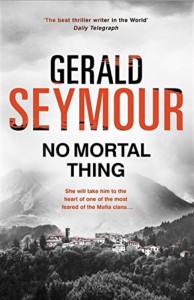No Mortal Thing marks Gerald Seymour’s return to an examination of Italian organised crime. Seymour previously touched on this in his novels Killing Ground and The Collaborator.
This time he turns his attention to the ‘Ndrangheta families in the Reggio Calabria region of southern Italy.
The novel deals with a young English banker called Jago Browne who is based in the Berlin offices of a large bank. One morning while waiting in a park before an appointment he sees a young Italian called Marcantonio Cancello extorting money from an Italian business in the city. When the incident turns violent he tries to intervene but is humiliated. Later when he goes to the police to report the crime the detective who interviews him basically tells him to accept the realities of life and forget it happened as he’s not going to change the world.
However the same detective, Fred, unwisely allows Jago to see his computer screen and identify the family of the young man in question.
In their home village in Italy the Cancello’s patriarch Bernardo is hidden in a secret bunker because the local prosecutor is trying to arrest him. The prosecutor has observers hidden watching Bernardo’s house for the appearance of the patriarch. As soon as his bolt-hole is identified he will be arrested. But the clock is ticking on the investigation and funding is to be withdrawn soon.
Jago becomes obsessed with striking a blow against the Cancello family and follows Marcantonio to Reggio Calabria where he finds his own vantage point above the family home. Here he can observe their comings and goings and thinks he can see where Bernardo must be hiding. Is this how he can get back at the family?
Meanwhile the German detective Fred and a British counterpart Carlo are sent to Reggio Calabria to liaise with the locals on finding Jago who could derail the prosecutor’s investigation.
The novel is quite suspenseful given that much of the story involves Jago hiding in a cliff and observing a house. As usual for a Seymour novel there are a large number of characters who’s path’s cross with Jago such as a young woman called Consolata who wants to hurt the criminal families for her own reasons.
Another memorable character is the local priest who has his own dark secret from the past resulting from his friendship with Bernardo. He gradually realises his days might be numbered and wrestles with what to do.
The descriptions of how the family controls the surrounding villages and demands respect is also well done. Seymour also paints a convincing picture of Jago, a young man with a promising career in banking who is angered by the arrogance of markantonio and becomes obsessed at hunting his quarry and taking him down a peg.
The suspense ratchets up a level for the conclusion and the book becomes a typical Seymour page turner.


